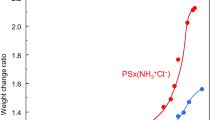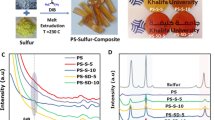Abstract
Poly(di-n-hexyl)silanes (PDNHS), which are σ-conjugated conductive polymers were synthesized by the conventional Wurtz-type coupling reaction. PDNHS were incorporated into polymer networks obtained by cross-linking vinyl terminated poly(dimethyl)siloxanes and methylhydrosiloxane-dimethylsiloxane copolymers. From the UV spectra of polysilane/polysiloxane composites, it can be derived that direct correlations exist between the structure of the polysiloxane matrix and the conformation of small amounts of added polysilanes. The degree of cross-linking plays an important role to understand the structure of the polysiloxane matrix. In addition, rheological measurements indicate that the mechanical properties and the degree of cross-linking in the PDNHS/polysiloxane composites are directly correlated. This implies that the optical properties of small amounts of added PDNHS can be correlated to the mechanical properties of the surrounding polymer matrix. Furthermore, this correlation confirms that PDNHS are suitable to probe the properties of complex polymeric structures.





Similar content being viewed by others
References
Brodinova J, Stejskal J, Kalendova A (2007) Investigation of ferrites properties with polyaniline layer in anticorrosive coatings. J Phys Chem Solid 68:1091–1095
Lu J, Moon KS, Kim BK, Wong CP (2007) High dielectric constant polyaniline/epoxy composites via in situ polymerization for embedded capacitor applications. Polymer 48:1510–1516
Liu Y, Cui T, Varahramyan K (2003) All-polymer capacitor fabricated with inkjet printing technique. Solid State Electron 47:1543–1548
Schottner G (2001) Hybrid sol-gel-derived polymers: applications of multifunctional materials. Chem Mater 13:3422–3435
Hakansson E, Amiet A, Kaynak A (2006) Electromagnetic shielding properties of polypyrrole/polyester composites in the 1–18 GHz frequency range. Synth Met 156:917–925
Argun AA, Aubert PH, Thompson BC, Schwendeman I, Gaupp CL, Hwang J, Pinto NJ, Tanner DB, MacDiarmid AG, Reynolds JR (2004) Multicolored electrochromism in polymers: structures and devices. Chem Mater 16:4401–4412
Miller RD, Michl J (1989) Polysilane high holymers. Chem Rev 89:1359–1410
Bernius MT, Inbasekaran M, O’Brien J, Wu W (2000) Progress with light-emitting polymers. Adv Mater 12:1737–1750
Braun D (2002) Semiconducting polymer LEDs. Mater Today 5:32–39
McGehee MD, Heeger AJ (2000) Semiconducting (conjugated) polymers as materials for solid-state lasers. Adv Mater 12:1655–1668
Colladet K, Fourier S, Cleij TJ, Lutsen L, Gelan J, Vanderzande D, Nguyen LH, Neugebauer H, Sariciftci S, Aguirre A, Janssen G, Goovaerts E (2007) Low band gap donor-acceptor conjugated polymers toward organic solar cells applications. Macromolecules 40:65–72
Cleij TJ, King JK, Jenneskens LW (2000) Band gap modifications in functionalized poly(methylphenylsilanes). Macromolecules 33:89–96
Watanabe A (2003) Optical properties of polysilanes with various silicon skeletons. J Organomet Chem 685:122–133
Ma N, Yu Y, Sun Z, Huang S (2007) Comparative study on the optical properties and stability of linear and branched polysilanes. J Lumin 126:827–832
Sanji T, Sakamoto K, Sakurai H, Ono K (1999) A statistical model for the cooperative thermochromic transition of polysilanes. Macromolecules 32:3788–3794
Rabolt JF, Hofer D, Miller RD, Fickes GN (1986) Studies of chain conformational kinetics in poly(di-n-alkylsilanes) by spectroscopic methods. 1. Poly(di-n-hexylsilane), poly(di-n-heptylsilane), and poly(di-n-octylsilane). Macromolecules 19:611–616
Arkles B (2000) Silanes, silicones and metal-organics, gelest catalog, Gelest Inc., PA
Rochow EG (1951) An introduction to the chemistry of the silicones. Wiley, NY
Author information
Authors and Affiliations
Corresponding author
Additional information
This manuscript has been retracted as the whole article was derived from the author’s master thesis without getting the consent of the author’s supervisor, Thomas J. Cleij, Hasselt University, Diepenbeek, Belgium nor the acknowledgement of Thomas J. Cleij's authorship.
An erratum to this article is available at http://dx.doi.org/10.1007/s00289-010-0365-z.
About this article
Cite this article
Lee, S. RETRACTED ARTICLE: A correlation between the optical and mechanical properties of novel polysilane/polysiloxane nanocomposites. Polym. Bull. 63, 385–396 (2009). https://doi.org/10.1007/s00289-009-0093-4
Received:
Revised:
Accepted:
Published:
Issue Date:
DOI: https://doi.org/10.1007/s00289-009-0093-4




